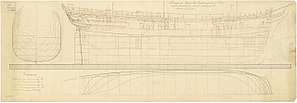HMS Providence (1791)
HMS Providence was a sloop of the Royal Navy, famous for being commanded by William Bligh on his second breadfruit voyage between 1791 and 1794.
 Providence | |
| History | |
|---|---|
| Name: | HMS Providence |
| Builder: | Perry & Co, Blackwall Yard |
| Launched: | 23 April 1791 |
| Acquired: | February 1791 |
| Commissioned: | April 1791 |
| Fate: | Wrecked on 16 May 1797[1] |
| General characteristics | |
| Class and type: | Sloop-of-war |
| Tons burthen: | 406 (bm) |
| Length: |
|
| Beam: | 29 ft 1 in (8.9 m) |
| Draught: |
|
| Depth of hold: | 12 ft 3 in (3.73 m) |
| Sail plan: | Full-rigged ship |
| Complement: | 100 |
| Armament: |
|
The Admiralty purchased Providence on the stocks from Perry & Co, Blackwall Yard in February 1791. She was launched on 23 April 1791 and commissioned under Bligh that month. She was coppered at Woolwich for the sum of £1,267, and then again at Deptford for £3,981.
Second Breadfruit Voyage
Rated as a sixth rate, she sailed for the Pacific on 2 August 1791 on Bligh's Second Breadfruit Voyage. Bligh completed a mission to collect breadfruit trees and other botanical specimens from the Pacific, which he transported to the West Indies. Specimens were given to the Royal Botanic Gardens in St. Vincent. Providence returned to Britain in August 1793, having been re-rated as a sloop on 30 September 1793.[2]
Vancouver Expedition
She underwent another refit at Woolwich and was recommissioned in October 1793 under the command of Commander William Robert Broughton. Broughton was ordered to rejoin the Vancouver Expedition and departed Britain on 15 February 1795. Reaching Monterrey long after the expedition made its final departure, Broughton decided (correctly) that Vancouver would not have left his surveying task unfinished and departed to chart the coast of east Asia.[3]
In the course of his explorations, he named Caroline Island Carolina (which later became "Caroline") "in compliment to the daughter of Sir Philip Stephens of the Admiralty."[4] This name superseded that given by Pedro Fernández de Quirós, a Portuguese explorer sailing on behalf of Spain; his account names the island "San Bernardo."[4]
Providence voyaged to Asia as the crew surveyed the coast of Hokkaidō Muroran before wintering at Macau, August 1796. There Broughton purchased a small schooner which proved providential when, on 16 May 1797 Providence was wrecked when she struck a coral reef at Miyako-jima, south of Okinawa. The wreck is described by the Ship's Astronomer John Crosley in a passage copied from the ship's log book.[1] Broughton and his crew continued the mission in the schooner, exploring northeast Asia, and returned home in February 1799.[5]
References
- Crosley, John. "Ship's Log". Cambridge Digital Library. Cambridge University Library. Retrieved 15 April 2015.
- "The Voyage of the Providence and Assistant 1791-1793". Fateful Voyage. Archived from the original on 14 March 2016. Retrieved 14 July 2018.
- Broughton, William Robert (1804), A voyage of discovery to the north Pacific Ocean : in which the coastal Asia, ... Japan ... as well as the coast of Corea have been examined and surveyed, performed in His Majesty's Sloop Providence and her tender in the years 1795, 1796, 1797, 1798, T. Cadell and W. Davies, OL 24159440M, retrieved 20 January 2012
- Kepler, A.K.; C.B. Kepler (February 1994). "The natural history of the Caroline Atoll, Southern Line Islands". Atoll Research Bulletin. 397–398. Archived from the original on 9 September 2006.
- Saunders, Emma; Steiner, Robert; Phillips, Eóin; Crosley, John; Broughton, William; Chapman, William; Hayward, John; Arnold, John; Earnshaw, Thomas (1787). Correspondence and related papers regarding observations made on voyages of discovery (RGO 14/68). Cambridge Digital Library. 1. Cambridge University Press. p. 293.
Bibliography
- Colledge, J. J.; Warlow, Ben (2006) [1969]. Ships of the Royal Navy: The Complete Record of all Fighting Ships of the Royal Navy (Rev. ed.). London: Chatham Publishing. ISBN 978-1-86176-281-8.
- Winfield, Rif, British Warships of the Age of Sail 1714–1792: Design, Construction, Careers and Fates, pub Seaforth, 2007, ISBN 1-86176-295-X
External links
